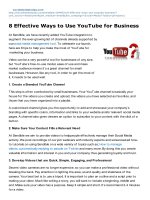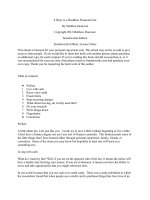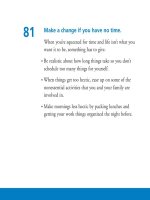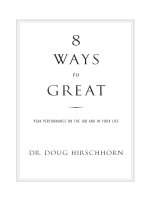8 ways to drive performance excellence
Bạn đang xem bản rút gọn của tài liệu. Xem và tải ngay bản đầy đủ của tài liệu tại đây (1.44 MB, 14 trang )
Best Prac ces in Quality, Cost and Delivery
COST
LIT
QUA
Implementa on Engineers Industry Insights
RY
8 Ways to Drive
Performance Excellence
E
IV
EL
Y
D
8 Ways to Drive
Performance Excellence
Table of contents
Introduction
3
Challenges during growth
6
The 3 challenges to performance excellence
7
Human Capital Development
8
Supply chain
9
Operations & Manufacturing
11
Big Data
12
Engineering & Product Development
13
Quality Management
14
Maintenance & reliability and Asset Performance Excellence
15
Total Performance Excellence & enCompass®
16
www.implementa on.com
Introduc on
To stay compe
ve, aerospace and defense companies are under intense pressure to op mize efficiency and effec veness. Future leaders in
the industry are those companies that can react quickly and maximize their full poten al. Although most companies establish con nuous
improvement programs to ensure quality, reduce costs, and drive delivery in the supply chain, op miza on of these programs through
incremental improvements is what leads to Performance Excellence. In this Implementa on Engineers Industry Insights paper, we outline
eight areas for improvement within a company while looking at best prac ces in producing quality, driving down costs, and mee ng delivery
commitments.
tal
api t
C
n
n
ma opme
u
H vel
De
Op
Ma era o
nuf
n
act s &
urin
g
Cus
to
erie mer
nce
(CX)
ce &
nan y
t
inte
Ma eliabili
R
Exp
r
o
f
s
a
ce
e
n
r
e
l
l
e
8A
c
x
E
e
c
n
a
Per for m
Performance
Excellence
y
alit nt
Qu eme
nag
B
Ma ig Da
nag ta
em
ent
ma
Eng
in
Pro eering
duc
t De &
v
in
Cha s
y
l
p
c
Sup ogis
L
&
8 Ways to Drive Performance Excellence
3
www.implementa on.com
Challenges during growth
Today, the aerospace and defense industries are experiencing a huge growth phase. In such a compe
ve market, to win a contract,
companies go through hundreds of steps and are selected only a er undergoing rigorous qualifica on processes to prove they can produce a
high-quality product at a high rate. The challenge is to ensure they simultaneously deliver the highest quality product while driving down
costs.
Ini ally, the company goes into an engineering, manufacturing and development phase with audits for manufacturing and produc on
readiness reviews (PRRs) to ensure they can fulfill all the requirements of the contract. A er the qualifica on process, the company goes into
the Low Rate Ini al Produc on (LRIP) phase where requirements and expecta ons are met through each phase of produc on.
For instance, say a company receives a defense contract to build a component for a F-35 Joint Strike Fighter. The defense contractor must
work through the process before going into a full-rate produc on environment. Along the way, they con nuously resolve any issues in the
process. Once the engineering firm is ready for produc on, they ramp up. This is a tough challenge, especially with lead me compression.
The overarching challenges during full rate produc on (FRP) are what companies strive to solve. Everything points to quality and efficiency.
A er the ini al LRIP phase, when the FRP environment begins, companies strive to meet the requirements while trying to resolve glitches,
quality issues and supply chain issues in manufacturing, con nuously working to improve.
Ramping up
Pr oduct ion
8 Ways to Drive Performance Excellence
Tough
C hal lenges
4
www.implementa on.com
A Strategy for Success
Companies need sound strategies to meet the growth. When the company begins produc on on several components per month, they
scale to demand. To accomplish this feat, they might need to change the infrastructure, hire employees and select strategic partners in
the supply chain. With all the moving parts in manufacturing, mee ng all the requirements is no easy feat. People must be trained to
communicate and coordinate across the value stream to implement changes quickly. In addi on, companies produce more in a
compressed me period, so they need greater throughput from supplier partners to meet delivery schedules. Results must be predictable
throughout the en re supply chain because if there is an issue, there will be a ripple effect.
In light of the challenges that aerospace and defense companies face, it is cri cal an op mized Performance Excellence program is in
place. Of course, op mizing a Performance Excellence program has its own set of challenges, but over the years Implementa on
Engineers has observed three main challenges when implemen ng Performance Excellence ini a ves. They are:
Quality
Cost
Delivery
Quality in Manufacturing - Companies must a ain 100% quality in all requirements for products and func onality across the supply
chain, This includes flawless execu on in quality manufacturing and sound strategies in business prac ces.
Cost Drivers - material costs, compliance costs, engineering costs, overhead costs, direct labor costs, manufacturing costs, cost of poor
quality and other costs to produce components must be analyzed, assessed and reduced. components must be analyzed, assessed and
reduced.
Delivery Schedules - with more orders, companies have greater demands for vendors and suppliers. This means that delivery schedules
must be met on me. Parts shortages, quality issues, and manufacturing lead me must meet expecta ons. There is less buffer to absorb
off-schedule condi ons and brute force doesn’t work at higher rates.
Implementa on Engineers breaks Performance Excellence down into eight categories. To be effec ve, companies turn to a specific
approach to reach sustainability and maintain quality in each one of these areas:
8 Ways to Drive Performance Excellence
5
www.implementa on.com
1. Human Capital Development (HCD)
People are the single most important asset in a company, so human capital development (HCD) is cri cal during a growth phase. When a
manufacturer ramps up produc on, typically they onboard and train new employees. Hiring new people in itself is a challenge for any
organiza on; training them to be proficient is another. Best prac ces is hiring people with the right skill set and making sure a structure is in
place before they step into the posi on.
Many companies have a senior workforce. The challenge becomes how to harness informa on to transfer their skills and knowledge to train
new hires. The structure must allow for mentors and coaches to have the me and resources to train new employees as they step into their
new roles. If people are busy doing their day jobs and suddenly they’re responsible for ten people, there’s no bandwidth for training.
Therefore, pu ng a succession strategy in place ahead of me, before hiring, is important.
Many companies start leadership programs and succession plans so new people can understand the scope of the organiza on through
func onal areas. A handoff occurs from both upstream and downstream partners to make sure everyone within the organiza on is more
effec ve and efficient. Having a rota onal program for high poten als where people learn various skill sets and understand the big picture
makes the team more func onal.
When companies ramp up, they will get all sorts of applicants with varying levels of experience. An effec ve training program should not be
one size fits all, but rather incorporate mul ple methods to ensure the knowledge transfer is effec ve for all the learning styles. For example,
companies need to train an engineer differently from an accountant, and need to train a 40-year-old differently than a college graduate.
When companies hire bright, young people out of universi es, these graduates may have some engineering knowledge, but need to be
trained on processes and procedures unique to the company. People coming out of school today learn a different way--they expect learning
that is visual and process driven with a well-defined system in place. It’s not like the old days of manuals and schema cs. Companies want to
transfer the informa on to the new hires in the fastest, most efficient way possible. Expecta ons for codifying knowledge need to be set
before new employees walk through the door.
Codifying Knowledge
Codifying Knowledge is arranging informa on as a systema c collec on of complementary methods that takes into account various learning
styles. When training is offered in mul ple ways, this enables people to understand standards and draw the same conclusions via different
methods. This may include hands-on simula on, classroom style, videos, tests/exercises, prac ce, observa ons, visual diagrams, etc.
It is proven that combining mul ple methods in a single training event is quite effec ve. When people can understand the context, purpose,
and details and implement the informa on into their day-to-day work, the training is successful. In manufacturing, codifying knowledge, both
wri en and unwri en, is relaying informa on so people of various learning styles can understand the processes efficiently.
Each person thinks and learns in new and different ways. When someone reads informa on efficiently a er 20 years, they have found best
prac ces. The key is teaching others how to access the informa on through best prac ces. Codifying that knowledge through a variety of
methods, like face-to-face training and virtual methods, will reach various learning styles. When a variety of touchpoints are used to transfer
the informa on, knowledge is gained more effec vely. Codifying knowledge ensures a collec on of methods are in place to train people in
different ways so they learn to perform at op mal levels of success.
8 Ways to Drive Performance Excellence
6
www.implementa on.com
2. Supply Chain
Supply chain includes an integrated set of processes to get a product to market. These processes include logis cs, warehousing, movement of
materials, vendor deliveries and manufacturing. Supply chain func ons go above and beyond to make sure all requirements are met to 100%
quality and delivery. Therefore, companies must keep a high level of accountability while keeping an eye on cost, changes in produc on and
quality in manufacturing.
Today, companies that flourish have excellent visibility into the supply chain in terms of produc on performance and any issues that may
impact quality. Supply chain is the link to profitability as companies with high performing supply chains achieve revenue growth greater than
average.
When people look at the supply chain holis cally they look at value added cost versus piece per price. For instance, when selec ng vendors,
for years people were focused on the best price. Today, companies find Total Cost is more important. This is a value-based way of looking at
supply chain versus price paid for a piece part. In mes of growth, suppliers who provide the best price may not always be the best strategic
or long-term company to partner with. Small vendors may may encounter delivery issues, which ul mately cost money in the long run. Large
vendors may lack flexibility to offer the service needs of the business. Suppliers must have the ability to handle the growth when there are
spikes in demand.
Supply chain must perform quality audits, especially during change. When customers change, requirements change. Aerospace and defense
companies learn how to do things be er and faster as they go through some mes thousands of design changes which can create a ripple
effect throughout the supply chain. Therefore, when changes occur, companies must communicate that to the supply chain so everyone is on
the same page and not course correc ng. When there are escapes, this indicates a lack of execu on. That’s why accountability and constantly
measuring the right behaviors is necessary.
8 Ways to Drive Performance Excellence
9
www.implementa on.com
3. Opera ons & Manufacturing
Opera ons & Manufacturing is the heart and lifeblood of a company. In opera ons, high-performance management is determined by how
well leadership sets up their teams for success by improving hour-by-hour and day-by-day, while execu ng flawlessly. When companies have
barriers or gaps, leadership needs to head them off before they become a big issue. Companies must have a con nuous process for
iden fying opportuni es and problems using data and observa ons to con nuously improve. However, many variables can get in the way of
execu ng flawlessly including managing people and reducing waste.
Managing human capital is part of the equa on. When someone steps into a new role on the manufacturing line, the leadership team has to
support them with good coaching. Expecta ons must be set so roles and responsibili es are clear. How well employees perform their jobs
must be measured and documented. When the structural components of roles and responsibili es are in place, employees can be successful.
Since employees are the ones doing the work, seeing the issues and having the best ideas to improve, it is best to harness their skills and
provide them with as much accountability as possible - this is cri cal in achieving a flexible and high performing workforce
Keeping down costs and reducing waste in manufacturing poses significant challenges to ROI as well. Lean is one of the tools
Implementa on Engineers deploys to eliminate waste in the process. Huge gains are usually possible by working on flow and reducing waste
by working collabora vely across support groups with process engineers, supply chain managers, and design engineers. Companies need to
reduce waste before they expand and build infrastructure to support growth. Transferring bad habits and poor processes to a new or
expanded facility can o en occur. A er taking an assessment and effec vely reducing waste, the scope of an expansion is o en less
necessary than ini ally perceived.
8 Ways to Drive Performance Excellence
11
www.implementa on.com
4. Big Data
Using data correctly makes top-level analysis seamless and requires fewer people or hours to get basic answers. However, showing data on a
dashboard is only part of the equa on. People o en jump to digital but need to know how to define processes, use structure and implement
a high-performance management (HPM) system to use the data effec vely. High performing companies today take data and turn it into
informa on that drives sustainable improvements, but a good founda on must be in place in order to use that data. The solu on is to be
data-driven and learn how to apply the data to make behavioral changes.
Implementa on Engineers is technology agnos c and outcome driven. We feel It is important to look at people through varying levels of the
organiza on to understand where the root cause of a problem originated. The digital dashboard allows companies to look across the value
stream, manufacturing, supply chain, procurement, and delivery with success. The goal is to deliver on me and within budget with the quality
required by the customer. Data can help do that.
Image Credit : varia on.com
Big Data in Ac on
A number of clients have jumped to digital solu ons without having a strong founda on. In many cases the companies were not using the
dashboard effec vely; they didn’t believe the numbers and they weren’t driving performance. In these circumstances it is best to get back to
basics which start with aligning the organiza on to the key performance indicators that will drive behavior and ensure sustainable results.
The company started wri ng the informa on down every two hours to see how it went, drilling into data. It took months of changing the
behavior. Then they got more advanced and changed the matrix and started using digi za on and dashboards. Eventually, they started
measuring more items. That’s the evolu on - having the founda on of pu ng in the right processes and leadership support in the place first
and then using technology to streamline the process.
8 Ways to Drive Performance Excellence
12
www.implementa on.com
5. Engineering & Product Development
Engineering and product development is the front end of the en re manufacturing process and can make or break the value stream. The
development team must thoroughly understand the voice of the customer so engineers come up with the effec ve, efficient designs to
maximize speed to market and customer performance. One challenge facing most engineers today is compression. Product design engineers
are more constrained which means they have less me and less budget to produce a more technologically-advanced product.
When Implementa on Engineers helps companies improve their design cycle, ini ally many client engineers and designers have good ideas
about how to improve manufacturing. However, part of the challenge is ge ng data back to the source and feeding key learnings back into
the group. Communica on spanning cross-func onal teams is vital to perfec ng engineering innova ons. Using approaches such as Design
for Six Sigma help drive product development and improve product quality while driving the reduc on in engineering changes during the
produc on phases.
With a higher volume of programs, companies want to design for manufacturability with representa on and coordina on across groups, so
addi onally the manufacturing folks, who have good ideas, are heard. Many mes, all teams aren’t properly integrated within ini al phases of
product design. Se ng up strong coordina on and communica on up front in design among key stakeholders ensures success during ini al
produc on.
Compression Challenges
Compression is the amount of me it takes to design a new product. With compression, companies have rapid changes that require them to
be more effec ve in the engineering processes. With more compression, companies want to make the right changes at the right me as
quickly as possible.
With compression comes challenges. Companies must:
Handle coordina on across groups
Increase visibility with the digital dashboard
Understand why they have engineering changes
Watch our
C ase St ud
y
V ideo
Determine which changes they can bundle together to implement the change.
The key is to coordinate all the efforts so that any change provides minimal disrup on to the full supply chain and value stream.
Making that process as seamless as possible is extremely important.
h ps://www.implementa on.com/freeresources/a-day-in-the-life-of-an-opera ons-leader/
8 Ways to Drive Performance Excellence
13
www.implementa on.com
6. Quality Management
Quality needs to be embedded in the culture across every single organiza on within the company to achieve 100% quality at all mes.
Companies need the right structure, skill set, and culture to a ain quality.
Some quality issues are supplier-related. O en, It is necessary to go back to the supply chain or vendor management for quality audits to
make changes. Other mes, issues are internally related and need addi onal coordina on and input from cross-func onal teams. Some
quality issues are paperwork-related, so companies look at why that is. Companies see major escapes because of a lack of execu on. Having
an accountability structure in place and ways to measure the right behaviors is important.
Implementa on Engineers takes a pragma c approach using preventa ve ac on through Six Sigma and data-driven approaches. This allows
for properly addressing root causes rather than going a er symptoms. Priori za on of opportuni es becomes key as every organiza on is
balancing me, budget and resources in driving towards 100% first pass yield. Some things can be fixed today; others things need different
problem-solving methodologies. Using the right tool for the right job is what companies need to strive toward.
7. Maintenance & Reliability
Companies must have good reliability programs in place for machine centers. When they start seeing varia on in what their equipment
produces, equipment might be lacking. Companies need preventa ve maintenance on equipment so it is producing as designed.
Without maintenance and reliability processes in place, companies may see varia ons in manufacturing. Maintenance and reliability is
sustainment post produc on which is the overhaul component. Many mes to grow, companies must look not only on the capital side, but at
machining centers, material flow, and infrastructures required to produce.
Focus on one
at a t ime
8 Ways to Drive Performance Excellence
14
www.implementa on.com
8. Total Performance Excellence
Total Performance Excellence means looking at every detail and taking a holis c view of the en re company with a strategy in place to
achieve performance. This means looking at the opera ons piece, tac cal piece, people piece and analyzing which ones are hur ng the
performance or which ones are going well.
Some companies try to tackle everything at once with limited success. An incoming consul ng company finds it hard to fix everything at once.
It requires them to break everything down and eat the elephant one bite at a me. They go through and assess the performance level and
maturity of each area before diving into where me, energy and focus should be spent. Typically, problem areas are solved with a be er
tac cal plan and be er execu on, improved training of people or repairing processes which are not effec ve and efficient.
Problem iden fica on is half of the equa on and how to resolve the problem is the other half. Each company has tools they’ve been trained
on it’s a ma er of using the right tools for the job. It’s important to focus on three ini a ves first which are people, processes and systems
and technology.
By looking at deficiencies around performance holis cally, companies will see some common elements and changes that need to be made.
Then they can align the quality, cost, and delivery they are looking for.
®
Project
Execu on
Opera onal
Strategy
Development
Implementa on
Planning &
Readiness
Performance
Strategy &
Resul ng
Ini a ves
Opera onal Strategy
Development Phase
Implementa on
Engineering
Program
Design Phase
Performance
Analy x®
Performance
Excellence
Opera ng
System
Training
& Skills
Development
Behavior
Change
Sustainable
Results
Organiza onal
Development
Implementa on Execu on &
Sustainability Phase
8 Ways to Drive Performance Excellence
15
www.implementa on.com
Summary
To keep up with the increasingly rapid growth within the aerospace and defense industries, companies have to become more streamlined and
produc ve than ever before. It is impera ve that companies stay flexible so they can react quickly and maximize their full poten al.
Established and con nuous improvement programs ensure quality, reduce costs and drive delivery. Op miza on of these programs through
incremental improvements helps companies to succeed. To achieve Performance Excellence (PE) a company should adhere to the eight areas
for growth poten al.
Following these guidelines is a good strategic plan for growth. To keep up with increasing produc on, companies con nually strive to improve
while looking at best prac ces in producing 100% quality in manufacturing, while keeping an eye on costs and maximizing delivery.
If people are on their own Island, in their own world, they may
op mize one area at the detriment of other areas. We ask our clients if
they understand the big picture and where we are going. If people
understand the big picture, then they can look at their day-to-day jobs
for ways to improve.
”
Mike Petsas
SVP Opera ons and Supply Chain
8 Ways to Drive Performance Excellence
17
NEXT STEPS
®
Schedule a mee ng with our team to learn about our enCompass methodology and
how IE can improve your opera ons
Interested in learning more about the topics covered in this white paper?
Call us at 1-312-474-6184 and reference the paper you’re interested in. We would love
to discuss your ini a ves.
Visit www.implementa on.com to find out more about our services
At our core, Implementa on Engineers is a data-driven, global firm with a razor-sharp
focus on enhancing mining and manufacturing opera ons.
We have volumes of success stories, and they can all be a ributed to our revolu onary
®
enCompass methodology. This industry-first approach gives us not only the knowledge
to inform you of what needs to be done but the power to actually implement those
solu ons for las ng impact.
10 S. Riverside Plaza, Suite 875, Chicago, IL 60606
1-312-474-6184









